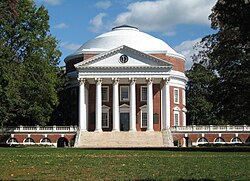Rotunda, University of Virginia | |
 The Rotunda | |
| Location | Charlottesville, Virginia, U.S. |
|---|---|
| Coordinates | 38°02′08″N 78°30′12″W / 38.03567°N 78.50340°W |
| Built | 1822–1826 |
| Architect | Thomas Jefferson; Stanford White |
| Architectural style | Early Republic, Neoclassical |
| Part of | University of Virginia Historic District (ID70000865) |
| NRHP reference No. | 66000937[1] |
| VLR No. | 002-5055 |
| Significant dates | |
| Added to NRHP | October 15, 1966 |
| Designated NHL | December 21, 1965[3] |
| Designated NHLDCP | November 11, 1971 |
| Designated VLR | September 9, 1969[2] |
The Rotunda is a building located on The Lawn on the original grounds of the University of Virginia. Thomas Jefferson designed it to represent the "authority of nature and power of reason" and modeled it after the Pantheon in Rome. Construction began in 1822 and was completed shortly after Jefferson's death in 1826. The campus of the new university was unique in that its buildings surrounded a library (the principal function of the Rotunda) rather than a church, as was common at other universities in the English-speaking world. To many, the Rotunda symbolizes Jefferson's belief in the separation of church and education, and represents his lifelong dedication to education and architecture. The Rotunda was designated a National Historic Landmark in 1966, and is part of the University of Virginia Historic District, designated in 1971.
The collegiate structure, the immediate area around it, and Jefferson's nearby home at Monticello combine to form one of only six modern man-made sites in the United States to be internationally protected and preserved as a World Heritage Site by UNESCO (the other five are the Old City of San Juan, the San Antonio Missions, Independence Hall, the Statue of Liberty, and the architectural works of Frank Lloyd Wright).
The original construction cost of the Rotunda was $57,773 ($992,792 in 2006 dollars). The building stands 77 feet (23.5 m) in both height and diameter.
- ^ "National Register Information System". National Register of Historic Places. National Park Service. April 15, 2008.
- ^ "Virginia Landmarks Register". Virginia Department of Historic Resources. Retrieved June 5, 2013.
- ^ "Rotunda, University of Virginia". National Historic Landmark summary listing. National Park Service. Archived from the original on October 6, 2012. Retrieved June 27, 2008.

